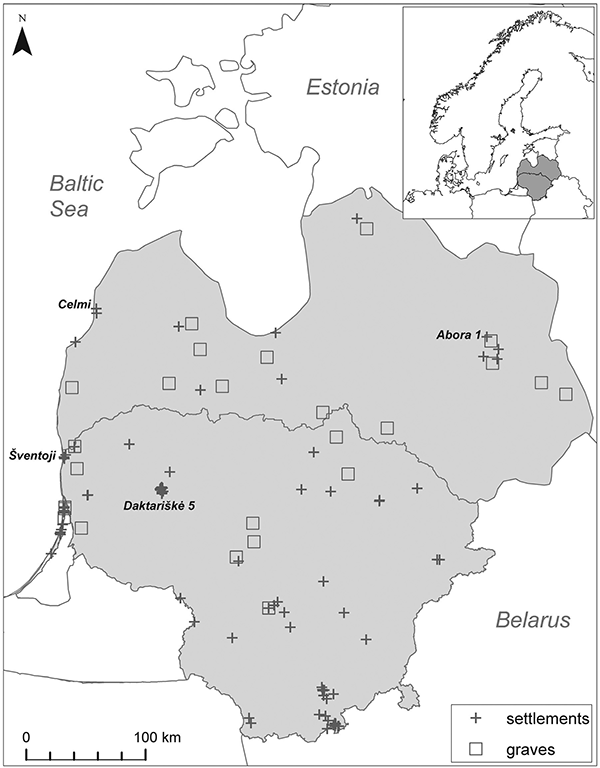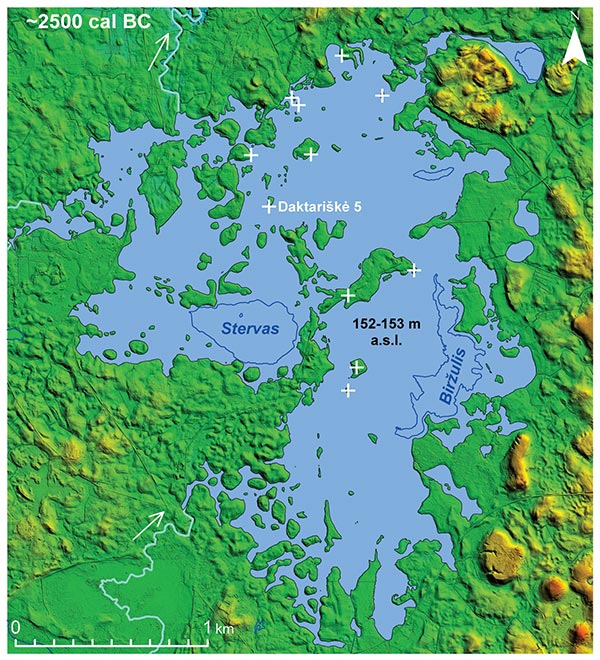New paper (behind paywall), Fishers of the Corded Ware culture in the Eastern Baltic, by Piličiauskas et al. Acta Archaeologica (2020) 91(1):95-120.
Interesting excerpts (emphasis mine):
Introduction
Traditionally the people of the Corded Ware culture (hereafter CWC) were considered mobile stock breeders who brought animal husbandry into the eastern Baltic, ca. 2800-2400 cal BC; a viewpoint substantiated by reconstructed settlement patterns and a lack of substantial structures at CWC sites, which despite being located in various environments have largely yielded little material culture. Indeed, the zooarchaeological evidence alongside the stable isotope data obtained from human bone collagen have generally been in agreement, pointing towards subsistence based on the consumption of terrestrial-derived protein (Lõugas et al. 2007; Piličiauskas et al. 2017a; 2017b; Piličiauskas 2018; Piličiauskas et al. 2018a). This paradigm, however, is beginning to change notably through the application of organic residue analysis of ceramic vessels whereby wild resources, including aquatic organisms, were processed (Heron et al. 2015; Piličiauskas et al. 2018b; Robson et al. 2019; Pääkkönen et al. 2020).
Although CWC groups occupied lakeshores previously inhabited by the pottery producing hunter-gatherer-fishers of the Subneolithic, they also resided in river valleys; the latter generally lacks evidence of habitation during this period. In Lithuania alone, the majority (80%) of CWC settlement sites have yielded less than five vessels per site, indicating a mobile economy (Piličiauskas 2018). Similarly, the lack of or scarcity of CWC dwelling structures and material culture, in general, has also been documented elsewhere (Edgren 1970; Loze 1992; Kriiska 2000; Nordqvist & Häkälä 2014; Nordqvist 2016). However, two wetland sites from the eastern Baltic do not conform to this general pattern. Daktariškė 5 in north-western Lithuania and Abora 1 in eastern Latvia are characterised by extraordinary rich CWC pottery assemblages with a minimal number of 59 and 100 vessels respectively, inconsistent with small bands of CWC herders moving throughout the mixed woodlands of the region.

Variability of the CWC economy in the Eastern Baltic
During prehistory, the three sites investigated in this study, Abora 1, Daktariškė 5 and Šventoji 58, were located near shallow water bodies within lacustrine or lagoonal environments, which would have been rich in aquatic fauna and flora. Given their abundance, it is perhaps not entirely surprising that aquatic resources continued to be exploited by the CWC people in the eastern Baltic. While the organic residue analysis of the CWC ceramics (Heron et al. 2015; Piličiauskas et al. 2018b; Robson et al. 2019) and zooarchaeological evidence (Piličiauskas 2018) corroborate the data presented here, the stable isotope analysis of human bone collagen largely contradict these. Indeed, these data generally demonstrate that the CWC people of the eastern Baltic mainly consumed terrestrial-derived protein, while a contribution of aquatic-derived protein, including freshwater fish, was evident for some individuals during certain times of their lives (Antanaitis-Jacobs et al. 2009; Piličiauskas et al. 2017a, b). Regardless, our data reinforce the notion that certain CWC groups were mainly fishers as opposed to farmers.
Our reconstruction of the Lake Bižulis water level and the palaeolandscape demonstrates that 9/11 known CWC sites in the area were situated on islands around ca. 2500 cal BC, which may have been selected for the mass capture and/or processing of fish as has been suggested elsewhere (Koivisto 2017). However, islets may also have been chosen for rearing livestock, which is corroborated by the presence of dairy fats in two CWC beakers from the site of Daktariškė 5 (Robson et al. 2019). Indeed, the selective rearing of livestock on islands has additional benefits, such as preventing escape as well as protection from predation and theft. (…)

Although the CWC communities migrated into the eastern Baltic as mobile stock breeders as evidenced by specific settlement patterns with many small sites scattered throughout various ecotones (Piličiauskas 2018), some groups, shortly after their arrival, incorporated fishing into their subsistence economies to varying degrees. This change was probably dictated by the local environment, for instance, the densely forested woodlands of the region. Abora 1 and Daktariškė 5 should, therefore, be regarded as localities illustrating a process of de-Neolithisation.
At Abora 1, the resident CWC group altered not only their subsistence economy, from stock breeding to fishing, but also their lifeway becoming more sedentary; as evidenced by the exceptionally large ceramic assemblage, a localised pottery-making tradition and pottery use principally directed towards the processing of wild resources. Alternatively, we can speculate that the CWC communities returned to Abora 1 numerous times over the course of several hundred years worth of deposition at the locality, which might account for the higher frequency of vessels.
At Daktariškė 5, fishing also became a significant part of the local CWC economy although stock breeding and the consumption/production/storage of dairy products persisted, perhaps symbolically (see Piličiauskas et al. 2018a) as demonstrated by the presence of dairy fats in two beakers (Robson et al. 2019). Here, pottery production was more in line with other sites in the eastern Baltic, implying a degree of mobility as well as contact/communication with the neighbouring CWC communities.
On the Baltic coast, aquatic resources continued to be exploited as evidenced by the rollable fish screen at Šventoji 58 as well as the remains of fish and presence of aquatic biomarkers in the CWC vessels discovered at the site of Alksnynė 3 (Piličiauskas 2018; Robson et al. 2019) and elsewhere (Heron et al. 2015; Pääkkönen et al. 2020).
Animal husbandry was, however, practised by other CWC groups and is perhaps clearer at sites located in the hinterland as demonstrated by the generally lower δ15N values of foodcrusts and greater occurrence of dairy and ruminant fats within ceramic vessels (Piličiauskas et al. 2018b; Robson et al. 2019). While the role of local hunter-gatherers in the re-Neolithisation process is poorly understood, further investigations into the CWC fishery sites are warranted.

Conclusions
To conclude, these data indicate that some CWC groups, particularly in lacustrine and coastal ecotones, partook in the process of de-Neolithisation and a return to hunting, gathering and fishing. Moreover, despite a change in the subsistence economy, there was no apparent change in pottery production. Indeed, these groups continued producing pottery akin to other assemblages from CWC sites in the eastern Baltic without incorporating other hunter-gatherer-fisher elements, thus demonstrating that the primary agent for the de-Neolithisation process was not the assimilation with local hunter-gatherers-fishers.
The return to hunting-fishing subsistence strategy was already known to have happened among Corded Ware-derived groups of Fennoscandia and the Forest Zone during the Bronze Age. Recent papers by Piličiauskas and colleagues are showing that this phenomenon was not merely constrained by a later worsening climate, but that it must have been a widespread process already among late CWC groups settling down and becoming “local”.
As the authors support based on material culture alone, this evolution was not the product – as previously suggested – of admixture with local sub-Neolithic groups, but rather a natural adaptation of mobile stockbreeders surrounded by forested areas rich in flora and fauna. Population genomics already confirmed that sampled groups around the Gulf of Finland are among the few European peoples to show major genetic continuity after the Corded Ware expansion and up to the Middle Ages, which explains their linguistic continuity.
Related
- Indo-Iranian influence on West Uralic through the Catacomb culture
- Early Uralic – Indo-European contacts within Europe
- Volosovo hunter-gatherers started to disappear earlier than previously believed
- Genetic continuity among Uralic-speaking cultures in north-eastern Europe
- Pre-Germanic and Pre-Balto-Finnic shared vocabulary from Pitted Ware seal hunters
- The Lusatian culture, the most likely vector of Balto-Slavic expansions
- European hydrotoponymy (IV): tug of war between Balto-Slavic and West Uralic
- Balto-Slavic accentual mobility: an innovation in contact with Balto-Finnic
- Corded Ware ancestry in North Eurasia and the Uralic expansion
- Uralic speakers formed clines of Corded Ware ancestry with WHG:ANE populations
- The cradle of Russians, an obvious Finno-Volgaic genetic hotspot